Another year, another Toyota Corolla.
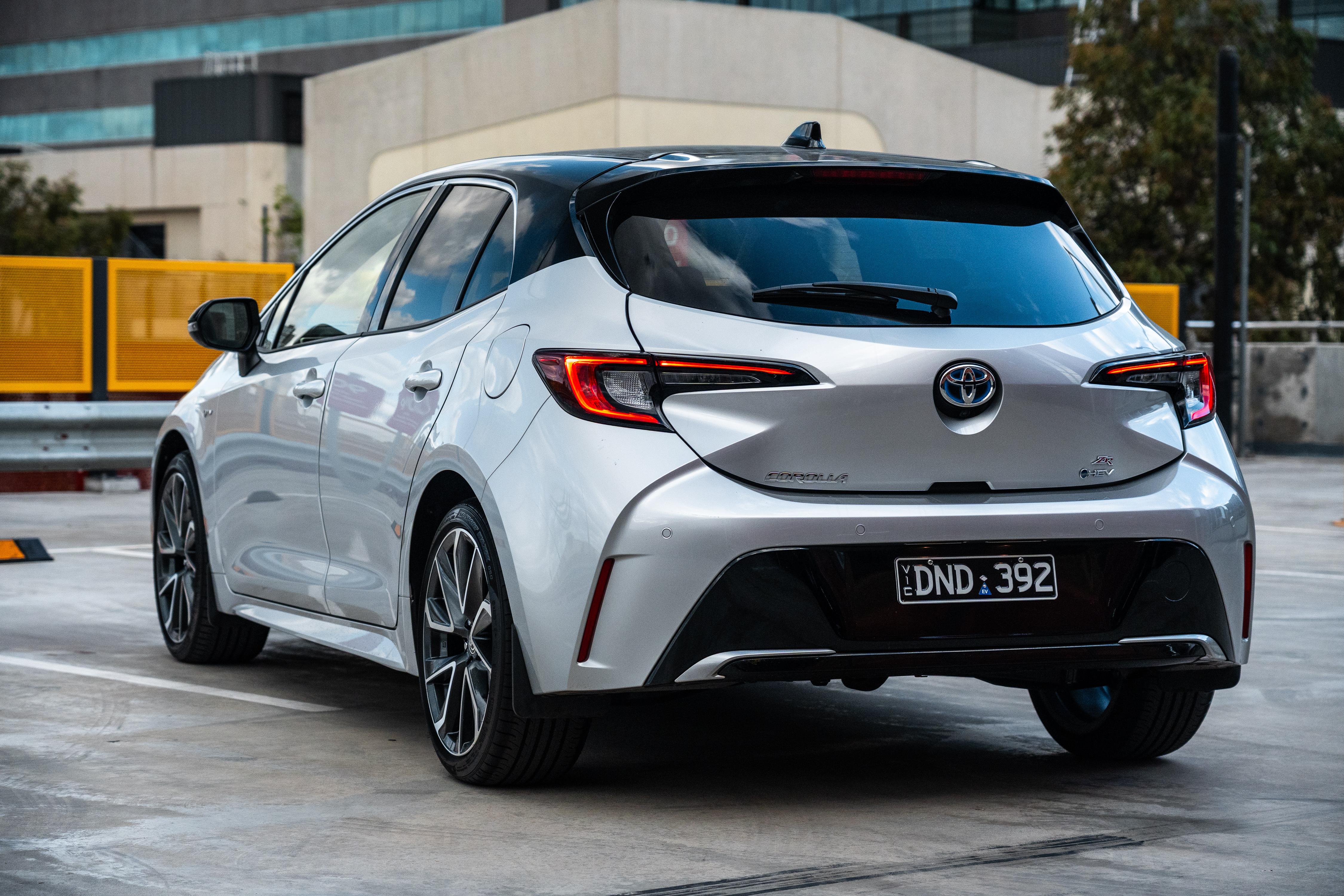
Toyota’s evergreen small-car nameplate is about to enter 2026 without wholesale changes – the popular small hatch and sedan is still all-hybrid, front-wheel drive, and automatic, and the people who will never buy one still say it’s too expensive.
But that’s not to say everything’s the same as it was at the start of 2025. While the three hatchback variants remain the same, it’s the less popular sedan range in which Toyota has decided to do a little pruning and shuffling.
Of note, the flagship ZR Sedan is no more, leaving the 2026 Toyota Corolla ZR Hybrid Hatch tested here alone at the top of Toyota’s small-car hierarchy. The Japanese brand says this was a logical move, with a spokesperson telling CarExpert that the ZR grade accounted for just 2.4 per cent of total Corolla sedan sales, “prompting a review of the lineup”.
Its discontinuation has resulted in a $265 price increase for each of the two remaining sedan variants, but they’ve also gained a 12.3-inch digital instrument display and wireless Android Auto as standard.
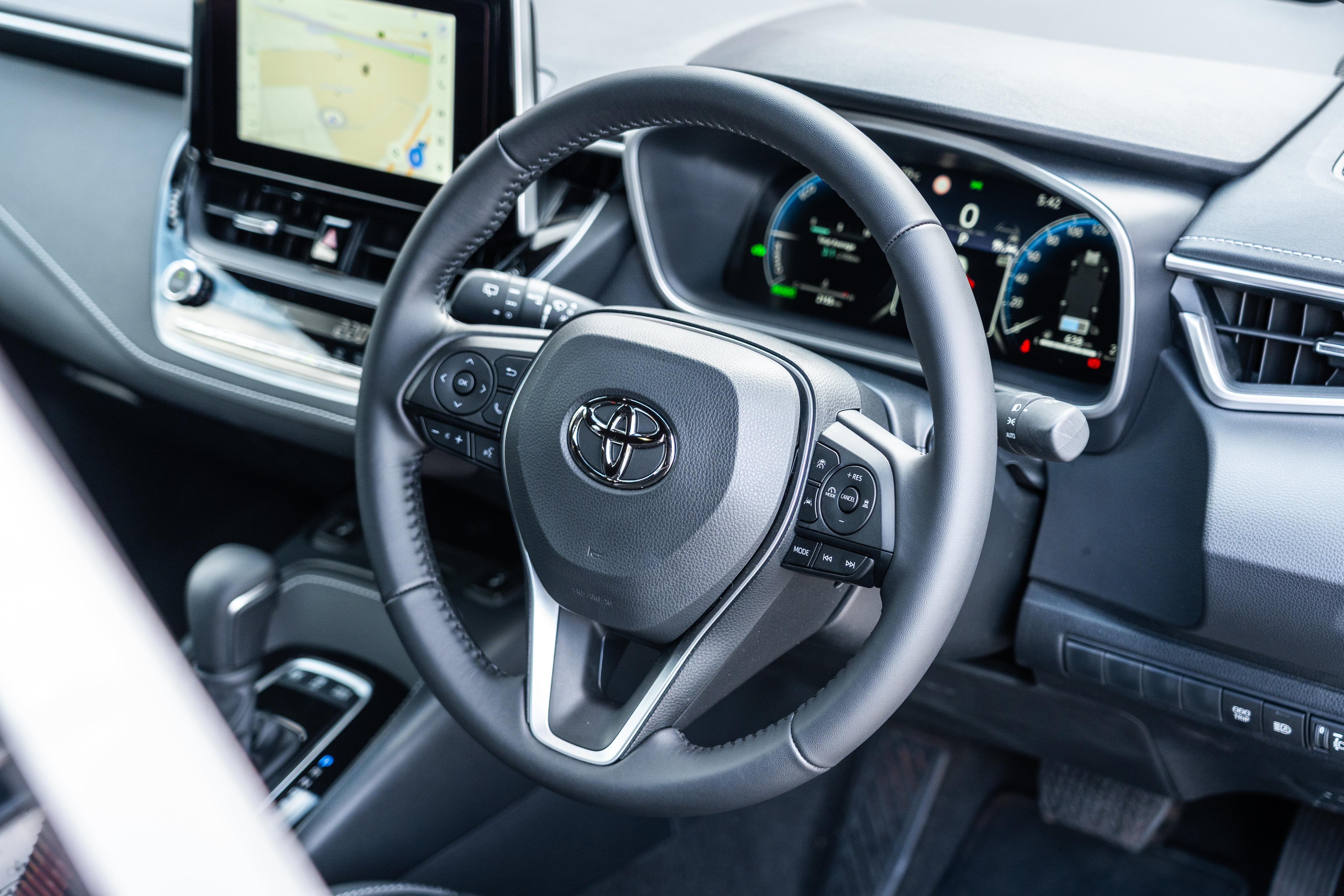
While the hatches haven’t gained anything new, they’re also no more expensive. That’s good news for our ZR Hatch tester, which is actually quite competitively priced against other top-spec small cars from the likes of Mazda and Hyundai.
As with Toyota’s reluctance to introduce big changes, repeat buyers appear as hesitant as ever to move away from the Corolla.
It’s comprehensively crushing its competition on the sales charts, posting nearly double the figures of the second-placed Mazda 3 so far in 2025. That means it’s Australia’s best-selling passenger car, albeit still less popular than all of the market-dominating utes and SUVs.
So what is it about the Corolla that keeps buyers coming back?
How much does the Toyota Corolla cost?
With the ZR Sedan discontinued, the ZR Hatch is the most expensive Corolla Hybrid currently on sale, at $39,100 before on-roads.
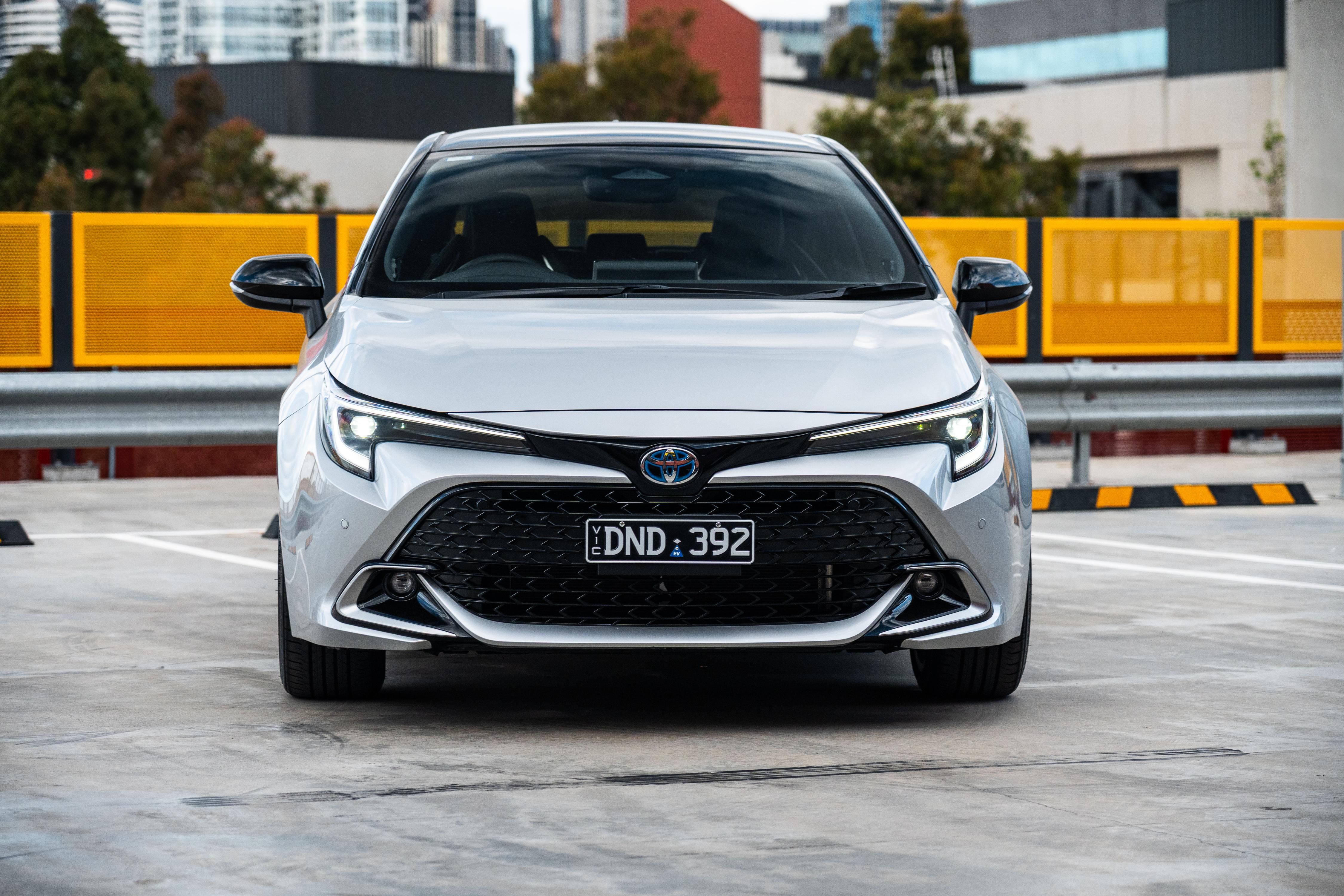
| Model | Price before on-road costs |
|---|---|
| 2025 Toyota Corolla Ascent Sport Hybrid Hatch | $32,110 |
| 2025 Toyota Corolla Ascent Sport Hybrid Sedan | $32,585 |
| 2025 Toyota Corolla SX Hybrid Sedan | $35,185 |
| 2025 Toyota Corolla SX Hybrid Hatch | $35,260 |
| 2025 Toyota Corolla ZR Hybrid Hatch | $39,100 |
Although it’s an entirely different ball game, the GR Corolla hot hatch is worth a mention, given it’s the most expensive Corolla ever. It costs $67,990 before on-roads for the manual, and $70,490 before on-roads for the auto.
Unlike its smaller but mechanically related GR Yaris three-door sibling, the GR Corolla has the same five-door body as the standard hybrid hatch but features several bespoke panels, including the front fenders, front bumper, bonnet, and roof. Of course, it also has an entirely different powertrain.
Otherwise, the Corolla ZR Hybrid tested here is best compared with top-spec versions of the Hyundai i30 and Mazda 3. The standard i30 hatch (excluding N variants) tops out at $41,000 before on-roads for the N Line Premium, while the flagship Mazda 3 G25 Astina costs $43,310 before on-roads.
There’s also the Subaru Impreza 2.0S hatch ($38,990 before on-roads), though the limited-run S-Edition currently pips it to the top spot at $42,490 before on-roads. The sedan-only Kia K4 GT-Line, meanwhile, costs $42,990 before on-roads.
To see how the Toyota Corolla stacks up against its rivals, use our comparison tool
What is the Toyota Corolla like on the inside?
Just as aged as the rest of the 12th-generation Corolla range, which dates back to 2018, albeit with a little more glitter.
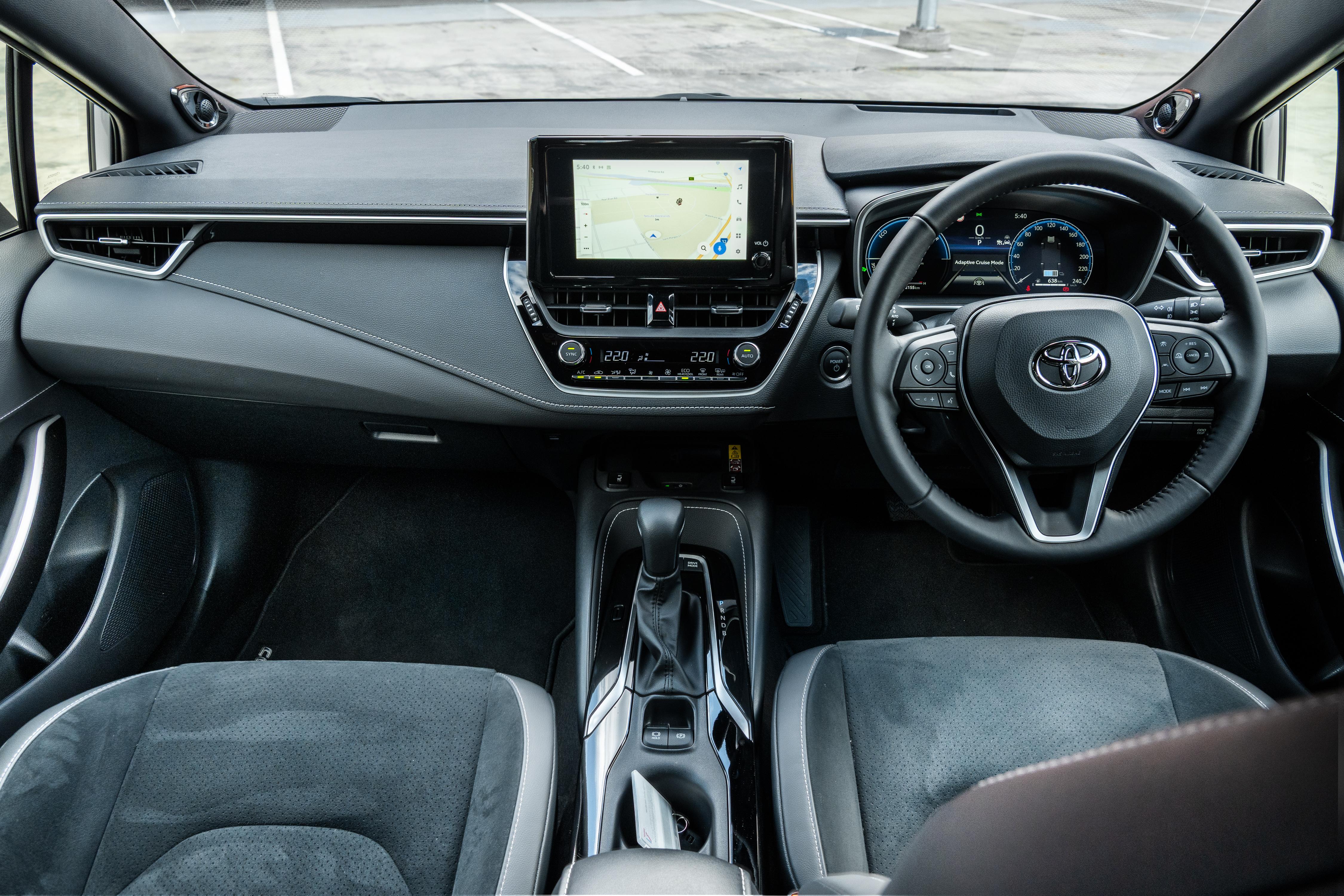
That doesn’t mean it isn’t still very utilitarian though, because that’s just how the current-gen Corolla is. That said, some nicer bits justify the ZR’s flagship status, making it a nice place to spend time.
Part of that is its top-notch ergonomics, something the Corolla is already very good at, while the rest is due to the ZR-specific seats. These are finished in a mix of cloth and synthetic leather, and they look suspiciously similar to the seats in the GR Corolla.
The only difference is there’s no GR embroidery, and they feel a touch softer than in that performance model. They’re still comfortable and hold you nicely, while offering a good range of power-assisted adjustment.
Then there’s the leather-wrapped steering wheel, again consistent with at least one lower-spec variant, which is perfectly sized in terms of rim thickness and diameter. Its buttons are finished in dull black plastic and are entirely physical, a benefit of both the Corolla’s hardy bones and its age.
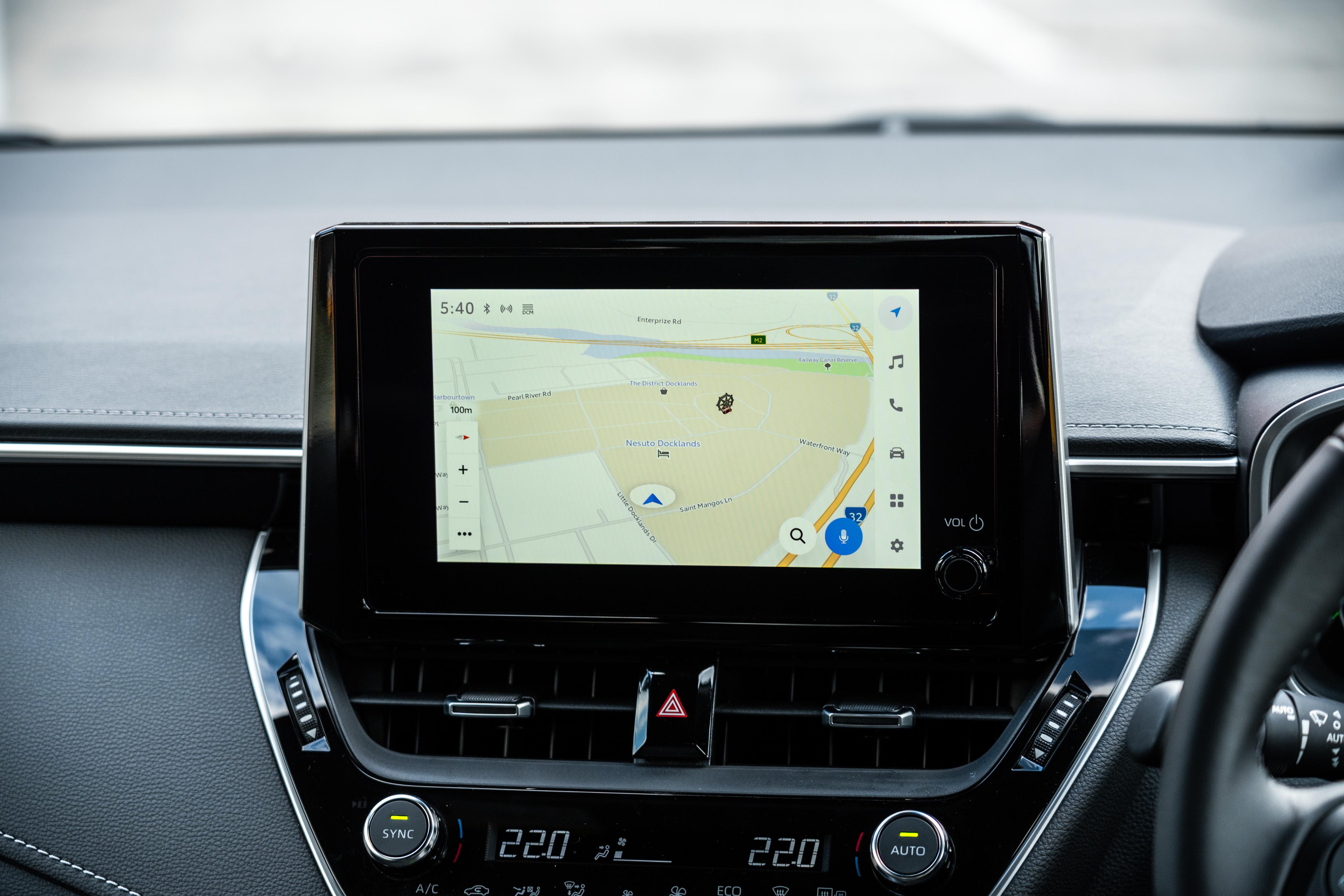

There are still some reminders that this is a budget-oriented car, as the dashboard and steering wheel boss look cheap, and there are other scratchy plastics on the centre console and door cards – though they aren’t really high-touch areas.
In front of the wheel is one of the real upgrades, though. The ZR gets a 12.3-inch digital instrument display, up from a partially digital 7.0-inch unit, which looks very classy and houses loads of information – even if it’s buried in countless menus that can be cumbersome to navigate.
The infotainment system, meanwhile, is unchanged. At 8.0 inches, it looks small by modern standards, sitting within a thick piano-black bezel, though it’s at least sharp and responsive, with a modern user interface and clean graphics.
Smartphone mirroring is also wireless, and we had no major issues with Apple CarPlay. Our historical issues with Toyota’s Bluetooth connectivity dropping out under Melbourne’s toll gantries didn’t crop up in our week with the ZR.

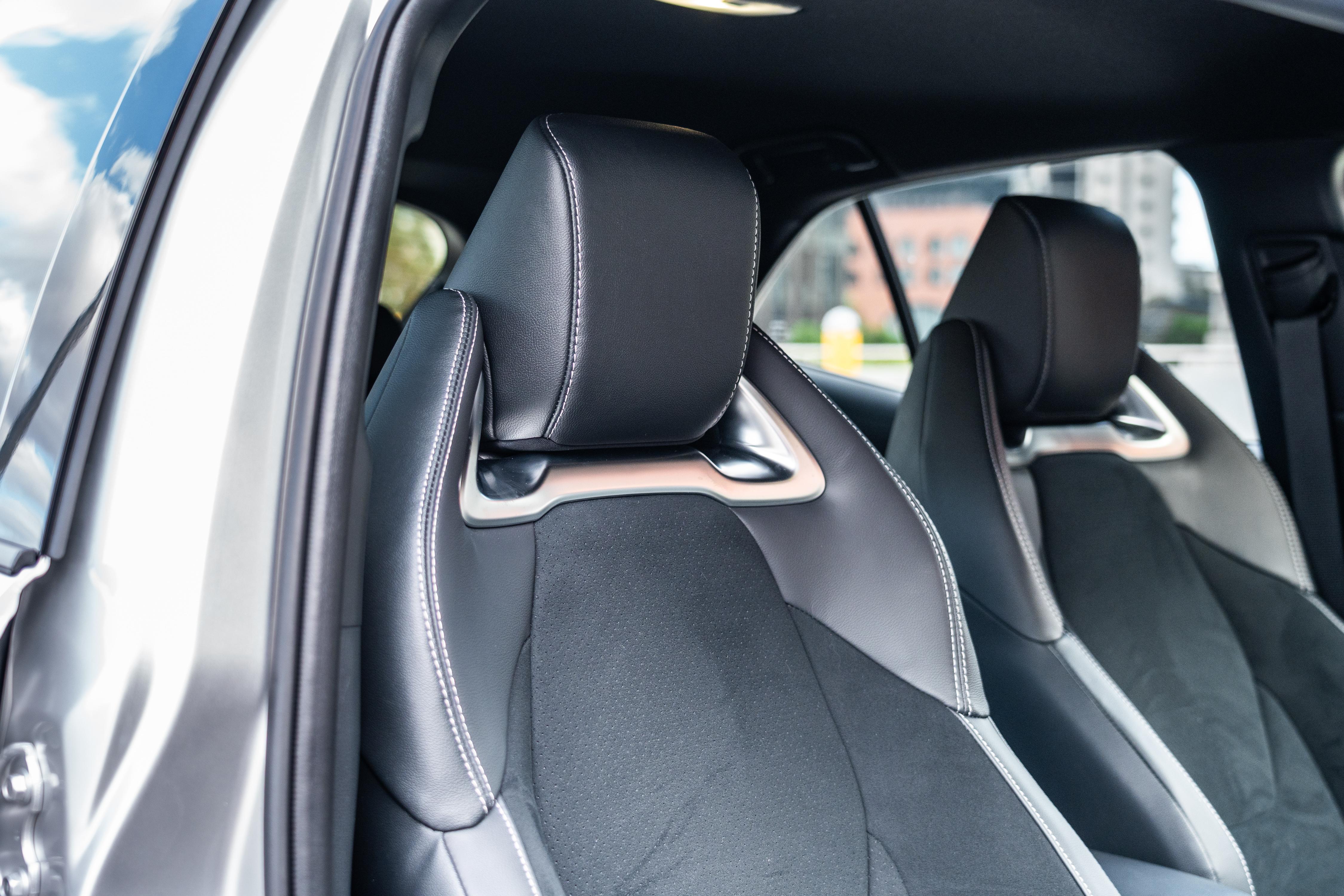
Further down is a physical climate control system, characterised by a row of silver-finished buttons in a sea of glossy black plastic. It’s far preferable to any screen-focused arrangement, but material choice isn’t great for a high-touch area.
There’s more piano black around the gear selector too, an area prone to scratching. The Corolla sticks with a traditional-style gear selector accented with leather, while there’s a handful of physical driving-related buttons nearby.
This leather-wrapped gear selector sits in front of switches for auto-hold and the electric handbrake, while there’s a single USB-C port in a mildly awkward spot on the dashboard in front of the passenger seat.
Storage options include a passenger-side glovebox and two cupholders tucked under the soft central armrest, which opens to reveal a small storage box. There’s a second USB-C port inside, making it the only real function that’s hidden away.


The black headliner creates a premium-feeling environment, but it does make the cabin feel small – not that we dislike that.
Nowhere is that more evident than in the rear, where it feels quite dark in combination with the high belt line. There are at least air vents on the back of the centre console, which is a nice upgrade from the SX below.
The leather parts of the ZR upholstery will hold up better to spills than the lower-spec cloth, but it’s still not ideal for transporting kids. The rear bench seat is at least soft, but space for fully grown passengers is tight.
Headroom is the most compromised, while legroom will be fine if the front seats aren’t slid too far back. The middle rear seat is especially squishy and hardly serviceable for grown adults, especially given the compromised legroom created by the ‘driveline’ tunnel.

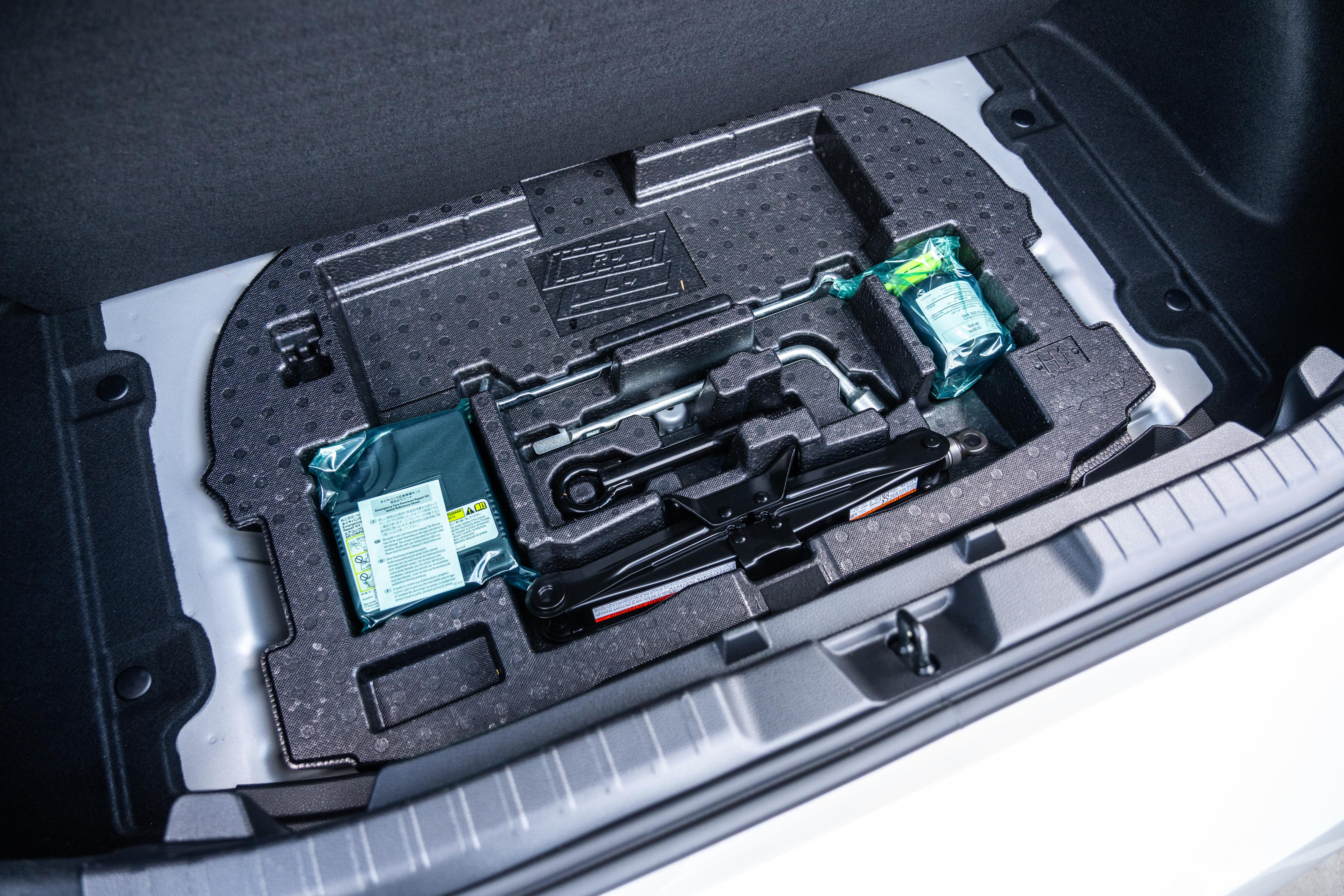
The boot’s relatively small, and the Corolla’s compact rear-end makes for a narrow load space. At 217 litres, it’s much smaller than the boot of the i30 hatch (395L) and the Mazda 3 hatch (295L).
It’s even smaller than the tight-looking Impreza, which is quoted at 291L – though measuring standards may not be consistent across the brands.
There’s at least a large, flat load floor with a low lip at the rear, making it easy to slide things over when loading. On either side are deep storage cubbies for loose cargo, but the parcel shelf does get in the way of taller items.
Unfortunately, there’s a tyre repair kit instead of a space-saver (let alone full-size) spare. You can still hang the boot floor by using a hook and the parcel shelf’s string to keep it out of the way, if you need to access anything underneath.
| Dimensions | Toyota Corolla Hatch |
|---|---|
| Length | 4375mm |
| Width | 1790mm |
| Height | 1435mm |
| Wheelbase | 2640mm |
| Cargo capacity (VDA) | 217L |
To see how the Toyota Corolla stacks up against its rivals, use our comparison tool
What’s under the bonnet?
Powering the Corolla range is a 1.8-litre naturally aspirated four-cylinder petrol engine, paired with a hybrid transaxle to produce peak power output of 103kW (Toyota doesn’t state a combined torque figure). Drive is sent to the front wheels through a continuously variable automatic transmission (CVT).
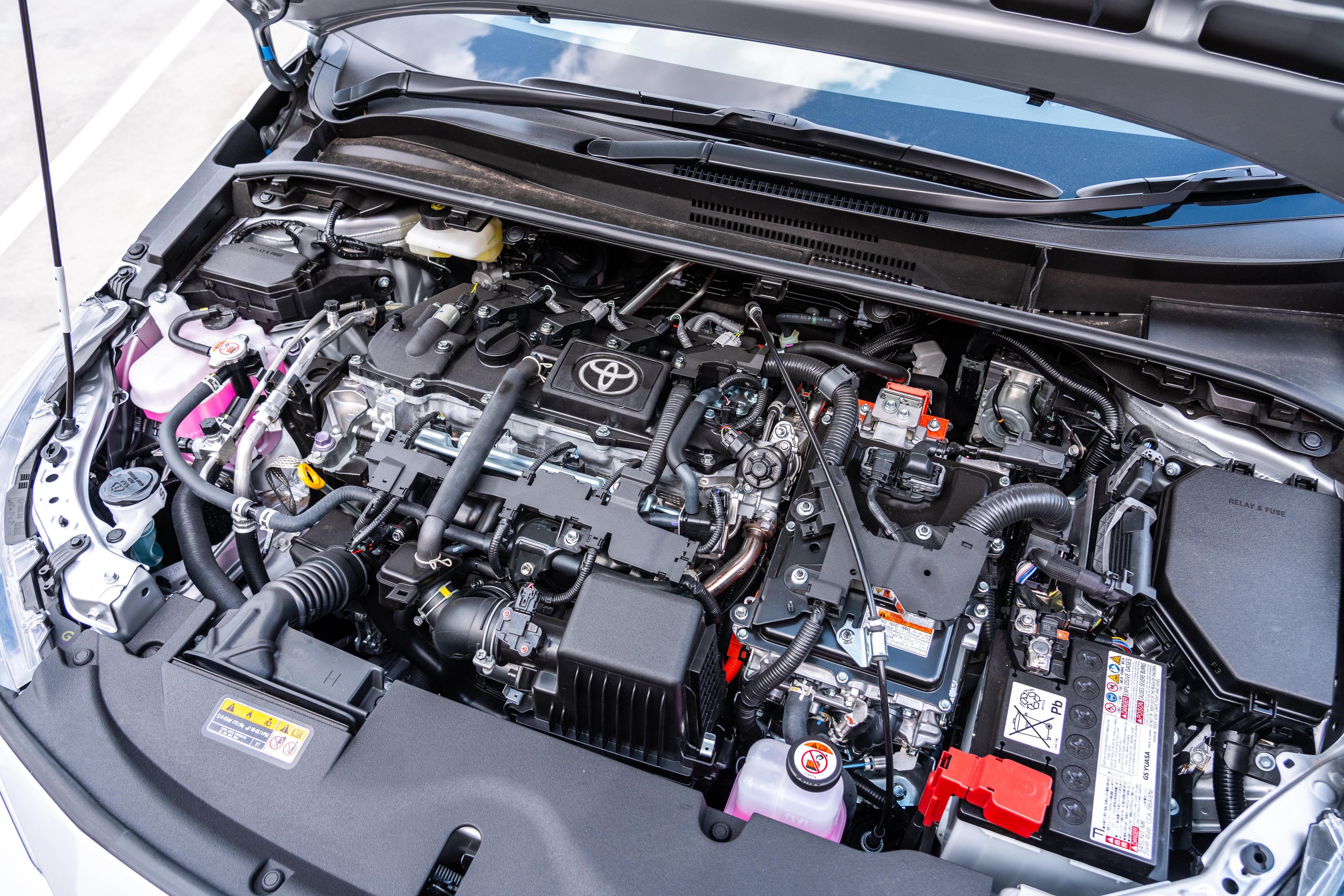
| Specifications | Toyota Corolla Hybrid |
|---|---|
| Engine | 1.8L 4cyl hybrid |
| Engine outputs | 72kW/142Nm |
| Peak electric outputs | 70kW/185Nm |
| Peak system outputs | 103kW |
| Battery | 1.3kWh li-ion |
| Transmission | e-CVT |
| Drive type | Front-wheel drive |
| Kerb weight | 1400kg |
| Fuel economy (claimed) | 4.0L/100km |
| Fuel economy (as tested) | 5.1L/100km |
| Fuel tank capacity | 43L |
| Fuel requirement | 91-octane regular unleaded |
| CO2 emissions | 85g/km |
| Emissions standard | Euro 5 |
Our week with the car predominantly involved highway driving, including a trip to the Lang Lang Proving Ground, which required the engine to work more often than usual. This contributed to our higher-than-claimed fuel economy, though it’s still very efficient.
To see how the Toyota Corolla stacks up against its rivals, use our comparison tool
How does the Toyota Corolla drive?
Even in flagship ZR form, the Corolla remains a generally unremarkable vehicle to drive.
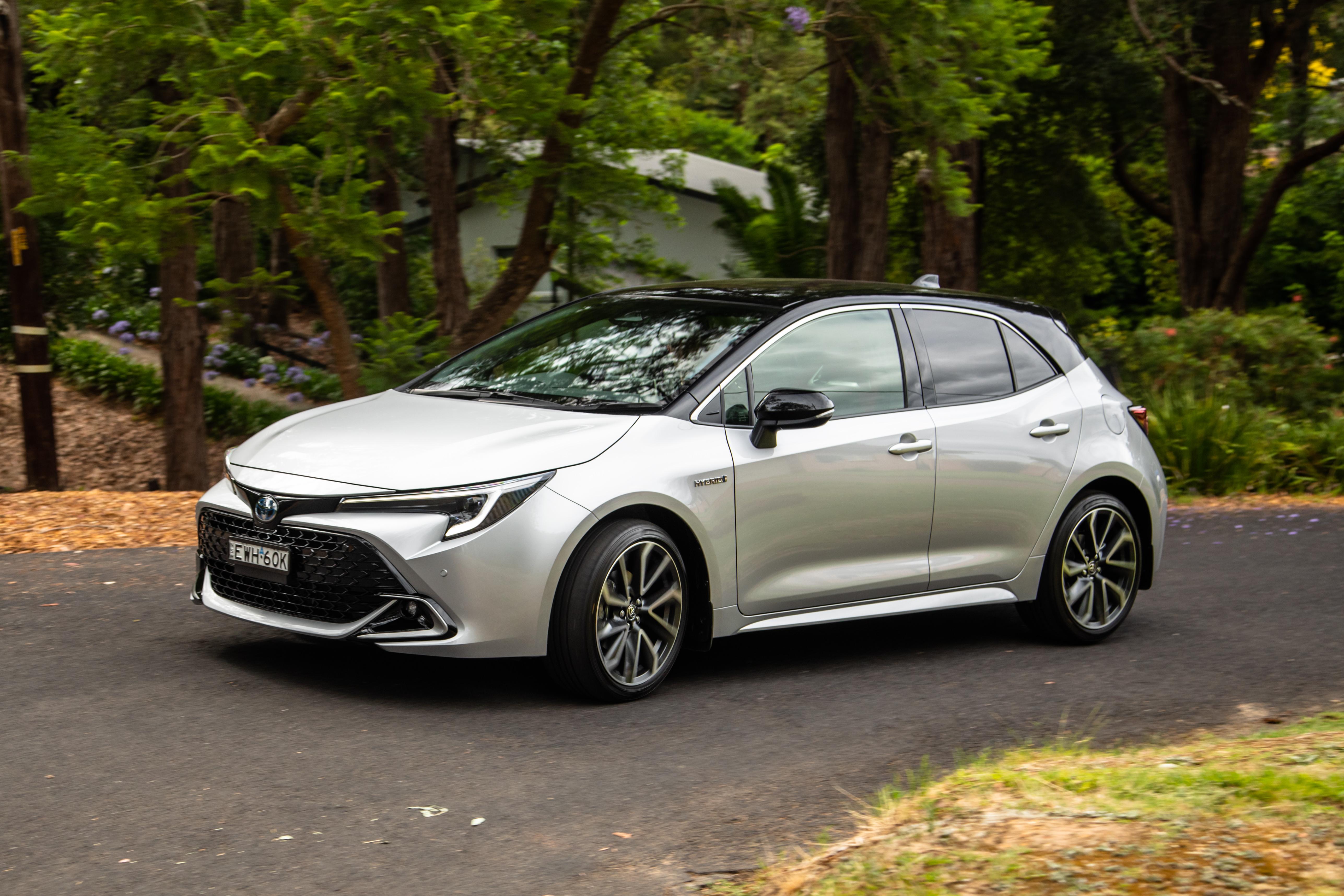
But the non-GR Corolla has been honed to excel in areas that Toyota considers crucial to the average buyer. It’s therefore supremely efficient, and though we weren’t able to achieve fuel consumption quite as low as we did in our recent review of the SX, circa-5.0L/100km is still very impressive.
You’ll also find the Corolla is smooth and sprightly under acceleration, offering decent performance for an economy car, and making it fittingly describable as ‘zippy’.
The engine still isn’t perfectly refined, revving drearily like many CVT-equipped powertrains do under hard acceleration. You will notice the hybrid system livens things up a bit, and the overall experience still feels segment-leading.
The powertrain’s decision-making about electric or petrol driving is also logical. You can lock it into EV mode at the press of a button, but it’ll automatically deactivate above speeds of around 40km/h – which is fine for city driving, so no complaints here.
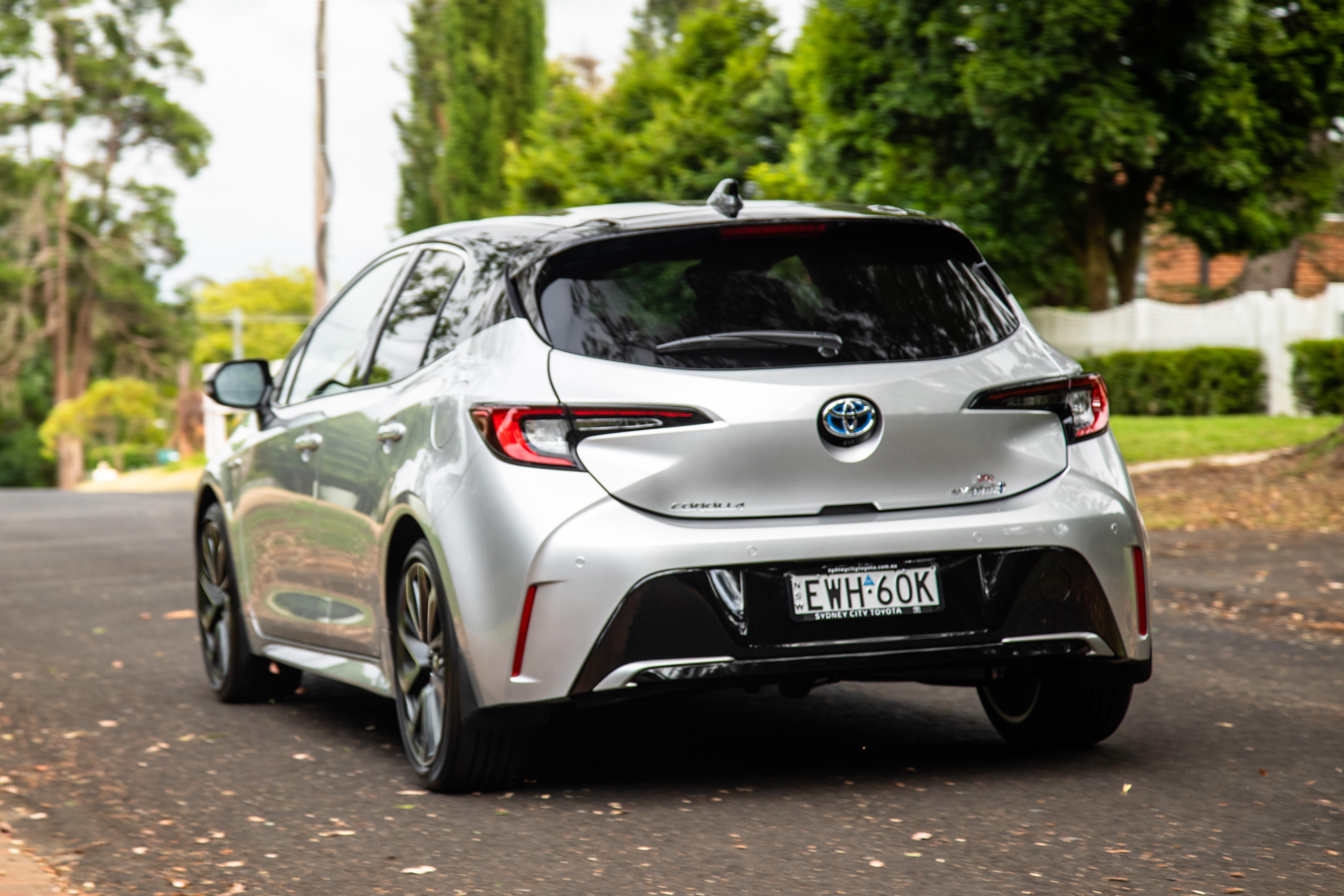
There’s also a small regenerative braking effect when charging the hybrid battery in ‘B’ mode. Though there are a handful of drive modes, actual differences between them are minimal – Sport mode makes the powertrain feel a little more alive, Eco mode saves fuel by leaning more into electric driving, and Normal mode is… well, normal.
As for dynamics, the Corolla has a well-balanced chassis, as evidenced by the very accomplished GR Corolla flagship, which also makes the non-performance versions all the more enjoyable to steer.
They’re remarkably well composed – surprisingly so for anyone even remotely interested in cars. While mainstream Corolla hybrid variants don’t feel sporty per se, the ZR’s tuning and more aggressive seats elevate the experience.
Paired with direct steering and a relatively taut suspension setup, the Corolla can also take bends with greater speed than usually seems reasonable. That stronger seat bolstering means you won’t be sliding around as much during turns either.
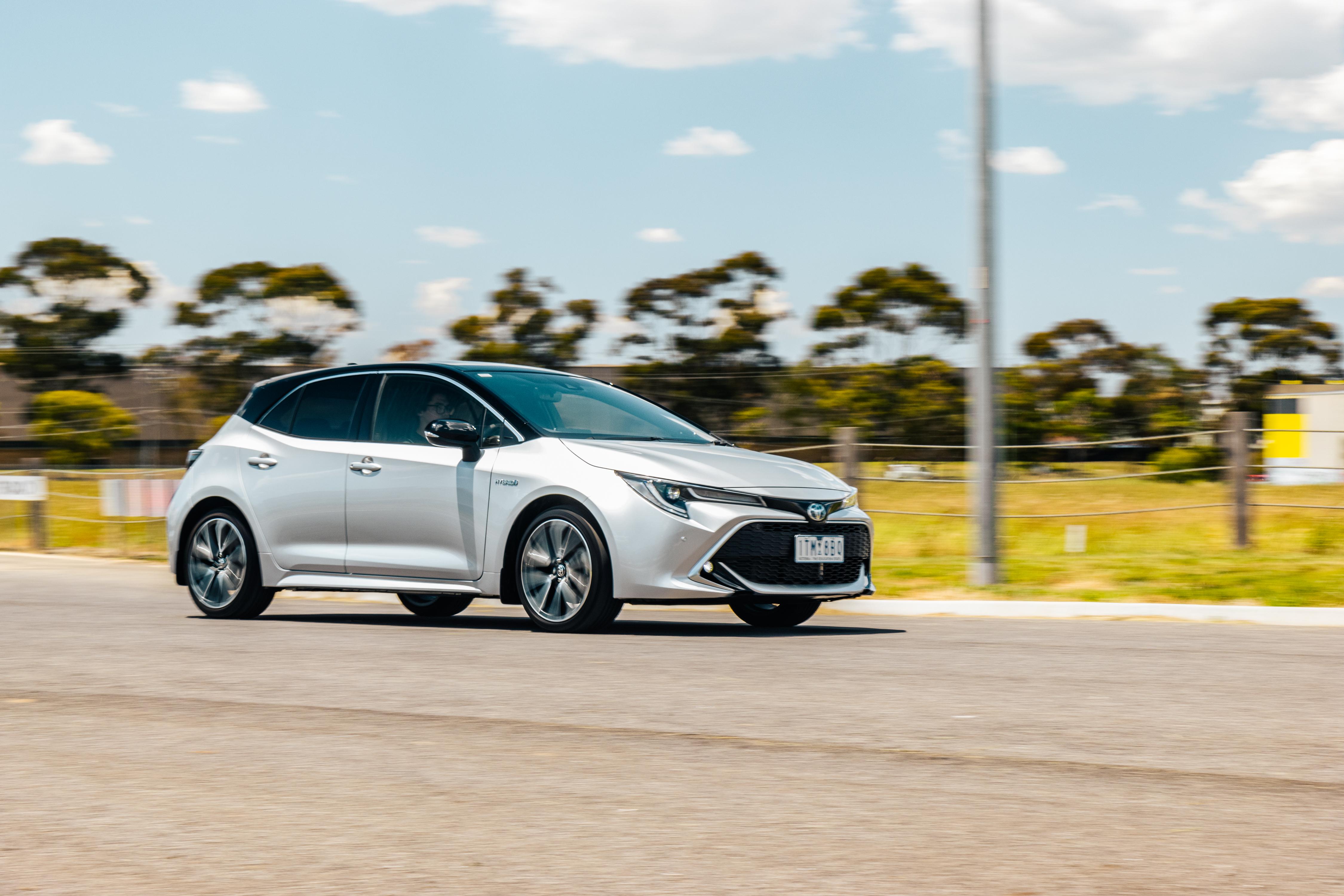
The Corolla is rarely unsettled in normal driving, even on rough Victorian roads at 100km/h or more. It inspires confidence, making it easy to predict what the car will do at any moment.
Adding to this is strong outward visibility, as the Corolla’s contoured rear-end doesn’t obstruct vision in any significant way. This is further enabled by an excellent driving position, with generous levels of powered seat adjustment allowing small adjustments on the fly.
You also get front and rear sensors and a decent reversing camera to assist with parking – unfortunately, however, there’s no surround-view monitor, even on the ZR.
On freeways, there’s also competent radar cruise control that nicely adapts to surrounding traffic. As is typical for Toyota though, it takes a moment to accelerate when changing lanes to overtake, which means you may need to stab the throttle to match traffic flow.
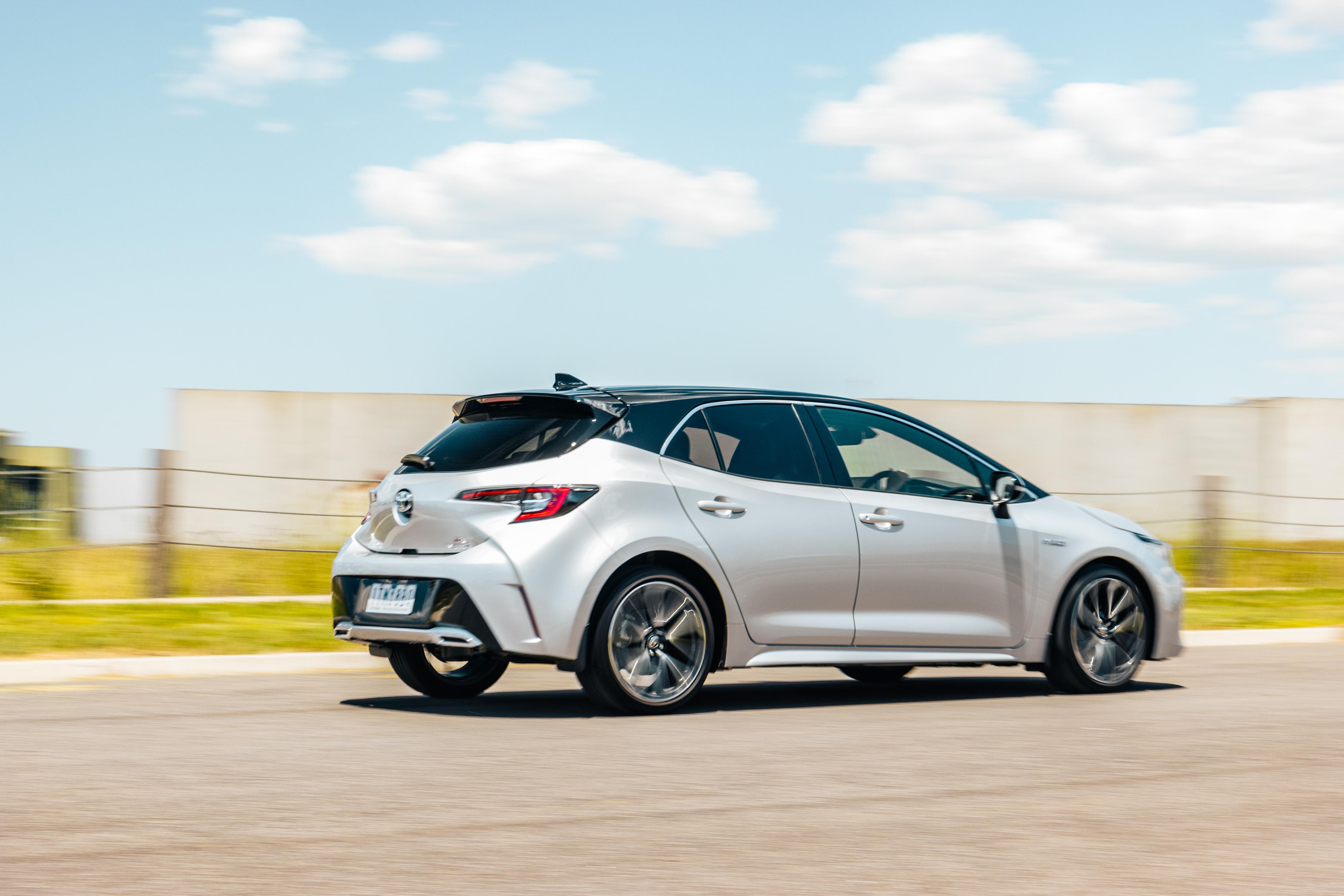
It’s rounded off with a lane-centring system that’s generally reliable, even if it’s hesitant to apply strong steering force around tighter bends.
Finally, refinement is good but not outstanding, as the larger 18-inch alloys of the ZR have an adverse effect on road noise. The SX, with 16-inch wheels, is more compliant as a result, making it a better fit for long-distance cruising.
The smaller tyre sidewalls here are more reactive to bumps, with less rubber to act as insulation. It isn’t unbearable on shorter drives, but you will notice it wearing on you as the kilometres and hours stack up.
Still, the Corolla is a convincing all-rounder, and despite some minor added flaws, the ZR does it with just a little bit more style.
To see how the Toyota Corolla stacks up against its rivals, use our comparison tool
What do you get?
The Corolla Hatch is offered in three grades – Ascent Sport, SX, and ZR.




2026 Toyota Corolla Ascent Sport equipment highlights:
- 16-inch alloy wheels
- Space-saver spare wheel
- Automatic bi-LED headlights
- Automatic high-beam
- Heated, power-folding mirrors
- LED daytime running lights and tail lights
- Cloth upholstery
- 12.3-inch instrument display (sedan)
- 7.0-inch instrument display (hatch)
- 8.0-inch touchscreen infotainment system
- Wireless Apple CarPlay
- Wired Android Auto (hatch)
- Wireless Android Auto (sedan)
- DAB+ digital radio
- Satellite navigation
- Illuminated vanity mirrors
- Rear seat reminder
- 6-speaker sound system
- Air-conditioning
- Toyota Connected Services (12-month subscription)
- Keyless entry and start
Corolla SX adds:
- LED fog lights
- Electric parking brake
- Rain-sensing wipers
- Auto-dimming rear-view mirror
- Leatherette-wrapped steering wheel, shifter
- Wireless phone charger
- USB charging port
- Satellite navigation
- Auto-folding side mirrors
- Keyless entry and start
- Privacy glass
- Remote climate control pre-conditioning
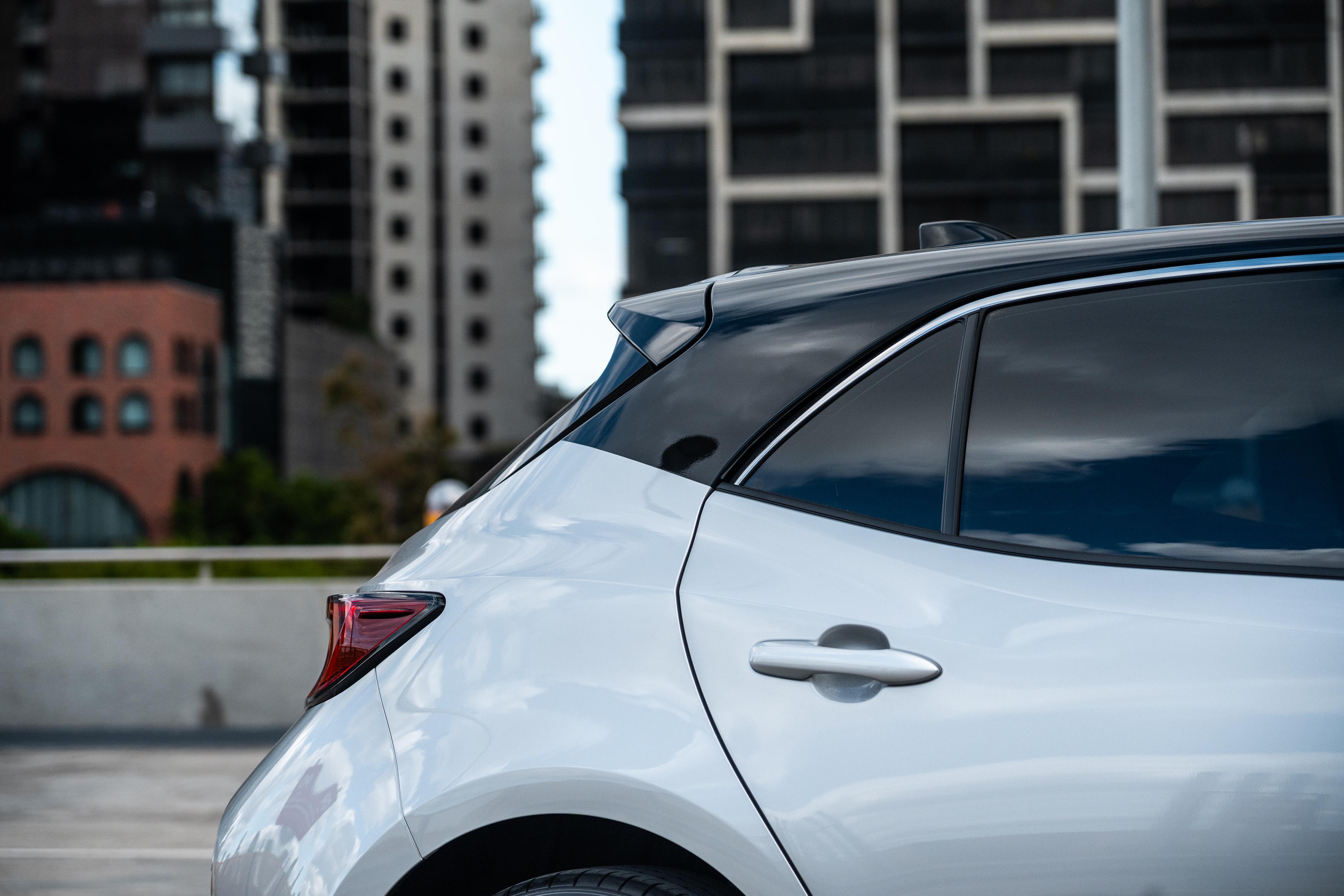
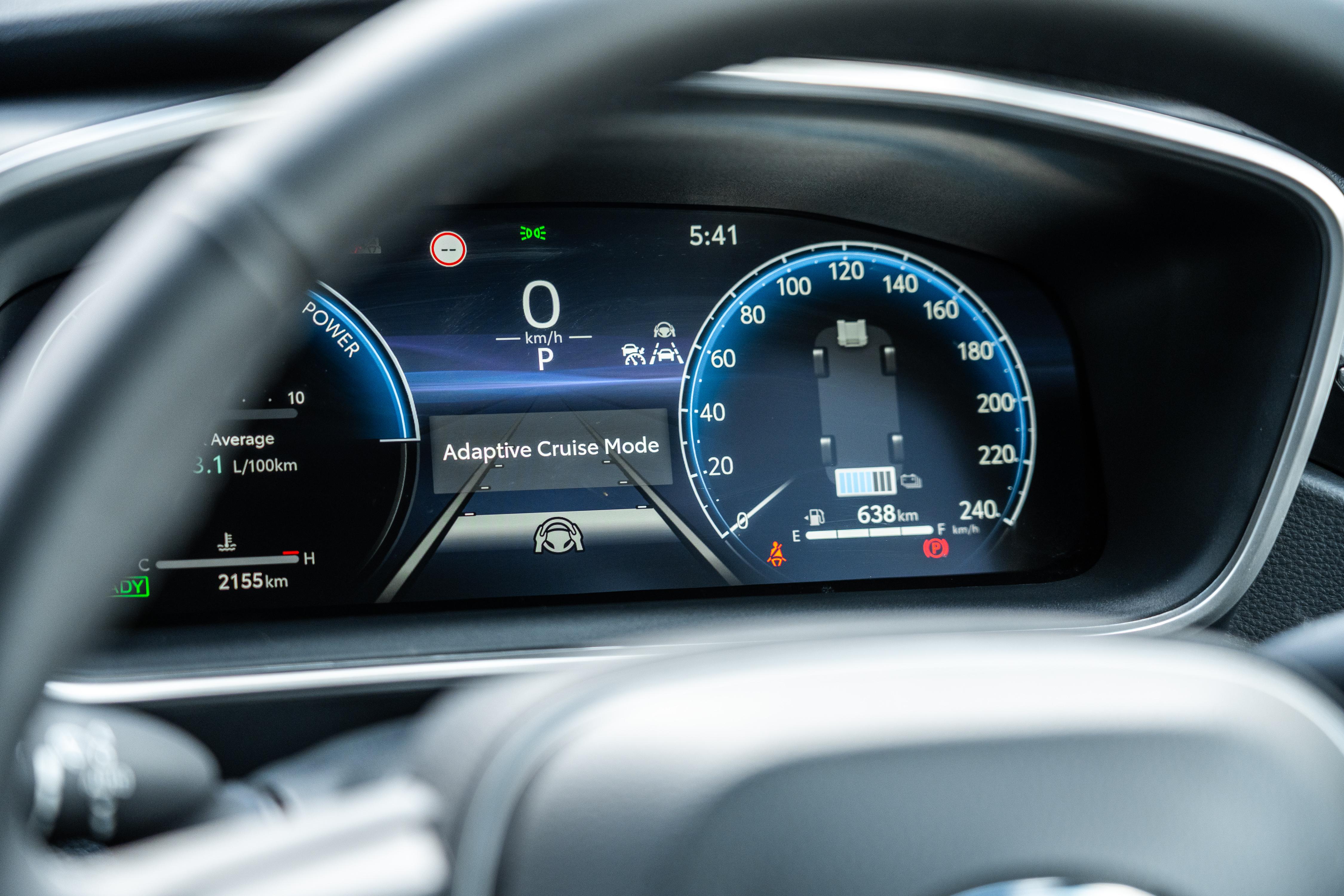
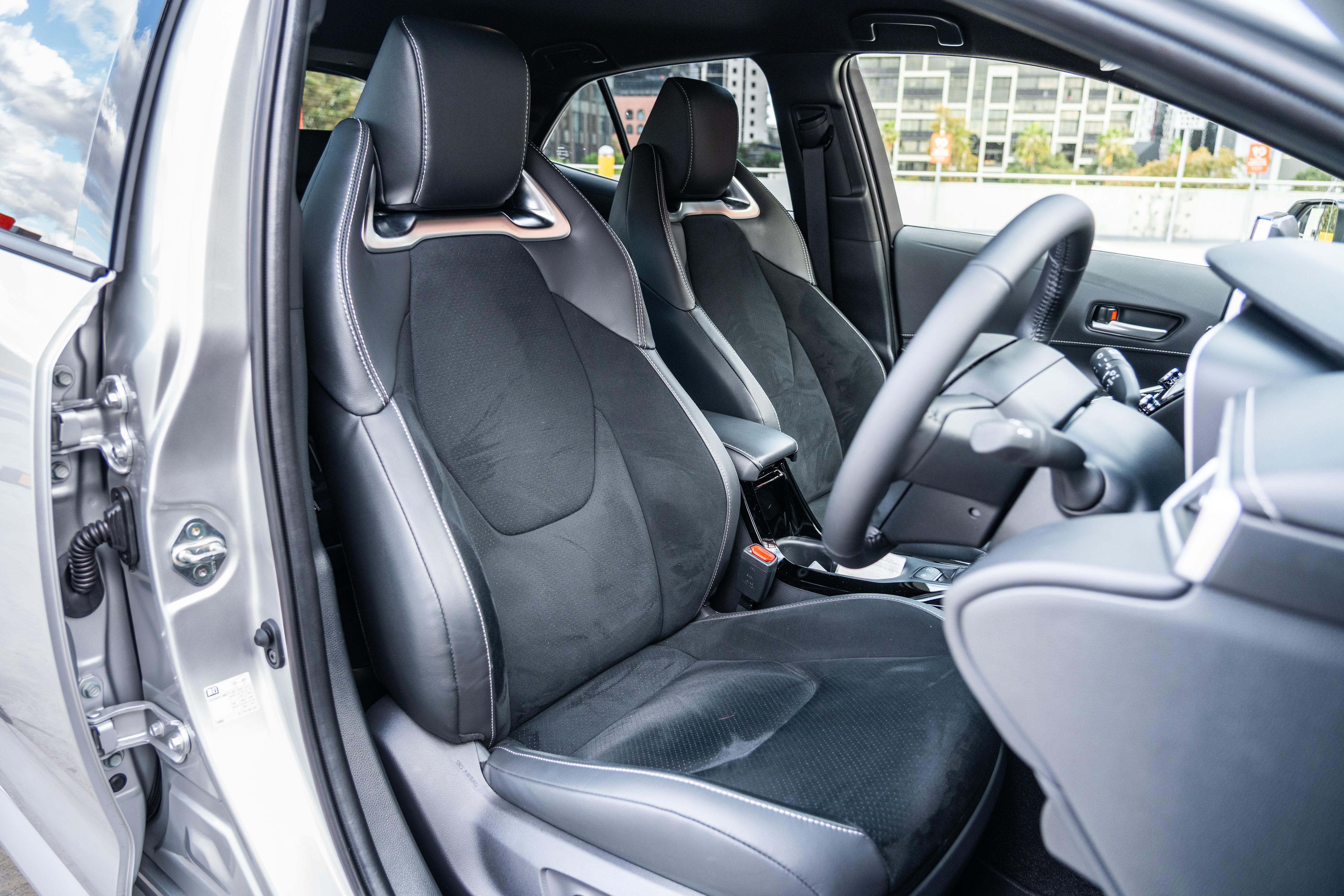
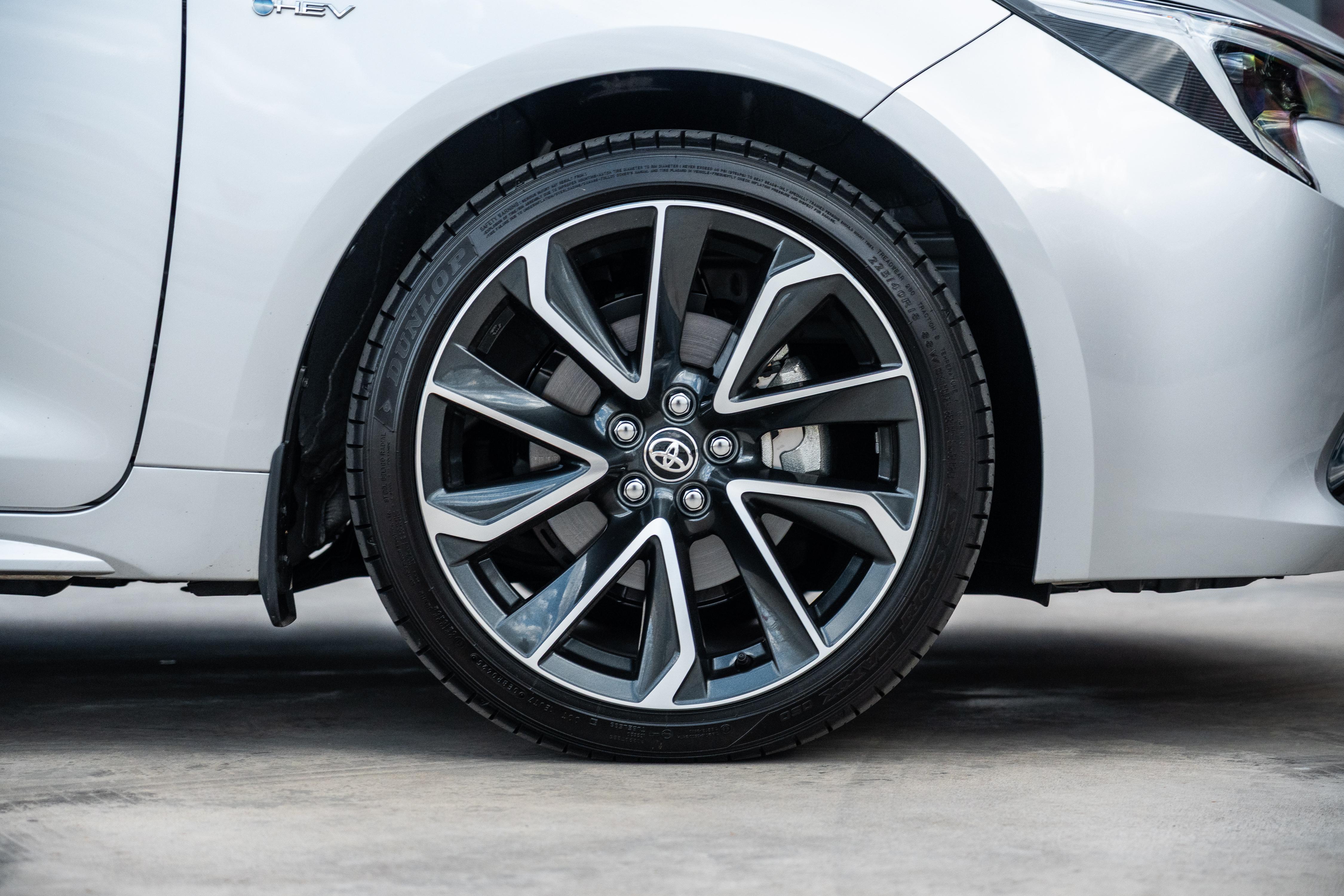
Corolla ZR adds:
- 18-inch alloy wheels
- Tyre repair kit
- Two-tone paint options
- 9-speaker JBL sound system
- Front sports seats
- 8-way power driver’s seat incl. lumbar
- Leatherette seat accents
- Heated front seats
- Head-up display
- 12.3-inch digital instrument cluster
- Auto-dimming rear-view mirror
- Ambient lighting
To see how the Toyota Corolla stacks up against its rivals, use our comparison tool
Is the Toyota Corolla safe?
Toyota Corolla vehicles built from January 1, 2025 are ‘unrated’ by independent auto safety body ANCAP, as the five-star rating it awarded in 2018 has expired.

Standard safety equipment includes:
- 7 airbags incl. driver’s knee
- Adaptive cruise control
- Autonomous emergency braking
- Pedestrian, Cyclist, Motorcycle detection
- Junction assist
- Blind-spot monitoring
- Emergency steering assist
- Lane departure warning
- Lane keep assist
- Lane Trace Assist
- Traffic sign recognition
- Reversing camera
- Safe exit assist
SX and up add:
- Front and rear parking sensors
- Rear cross-traffic alert
To see how the Toyota Corolla stacks up against its rivals, use our comparison tool
How much does the Toyota Corolla cost to run?
The Corolla is backed by Toyota Australia’s five-year, unlimited-kilometre warranty, which extends to seven years for the engine and driveline provided the car is serviced on time and within the Japanese brand’s national dealer network.

| Servicing and Warranty | Toyota Corolla Hybrid |
|---|---|
| Warranty | 5 years, unlimited kilometres |
| Roadside assistance | $99 or $139 per year, depending on plan |
| Service intervals | 12 months or 15,000km |
| Capped-price servicing | 5 years ($250 each) |
| Total capped-price service cost | $1250 |
For context, the Hyundai i30 costs $1838 to service over five years (averaging $367.6 annually), while the Mazda 3 costs $2284 over the same period, averaging $456.8 per year.
To see how the Toyota Corolla stacks up against its rivals, use our comparison tool
CarExpert’s Take on the Toyota Corolla ZR Hybrid hatch
We’ve said it before and we’ll say it again: the Corolla is a clear segment leader, even as the years wear on, for good reason.

As is true with most other modern Toyotas, the Corolla’s feels very familiar and unintimidating, and the age of this generation won’t be a problem for the most traditional motorists. Indeed, consistency is what helps make the Corolla appeal to all sorts of Aussie car buyers, who will quickly also begin to see savings thanks to the car’s hybrid prowess.
Refinement, reliable safety and multimedia tech, and nice-feeling interior touchpoints will make long-term ownership more satisfying, and the composed ride and handling are simply a bonus.
The only thing is that the ZR probably isn’t the pick of the range. The thinner tyres and sportier seats that help make it sportier are not conducive to comfortable cruising, which becomes apparent after spending a couple of hours on shoddy Aussie highways.
It still offers surprisingly decent value for a flagship variant and remains impressively efficient, but these niggles do reinforce our sentiment that the mid-spec Corolla SX is the true sweet spot in Toyota’s small-car lineup.
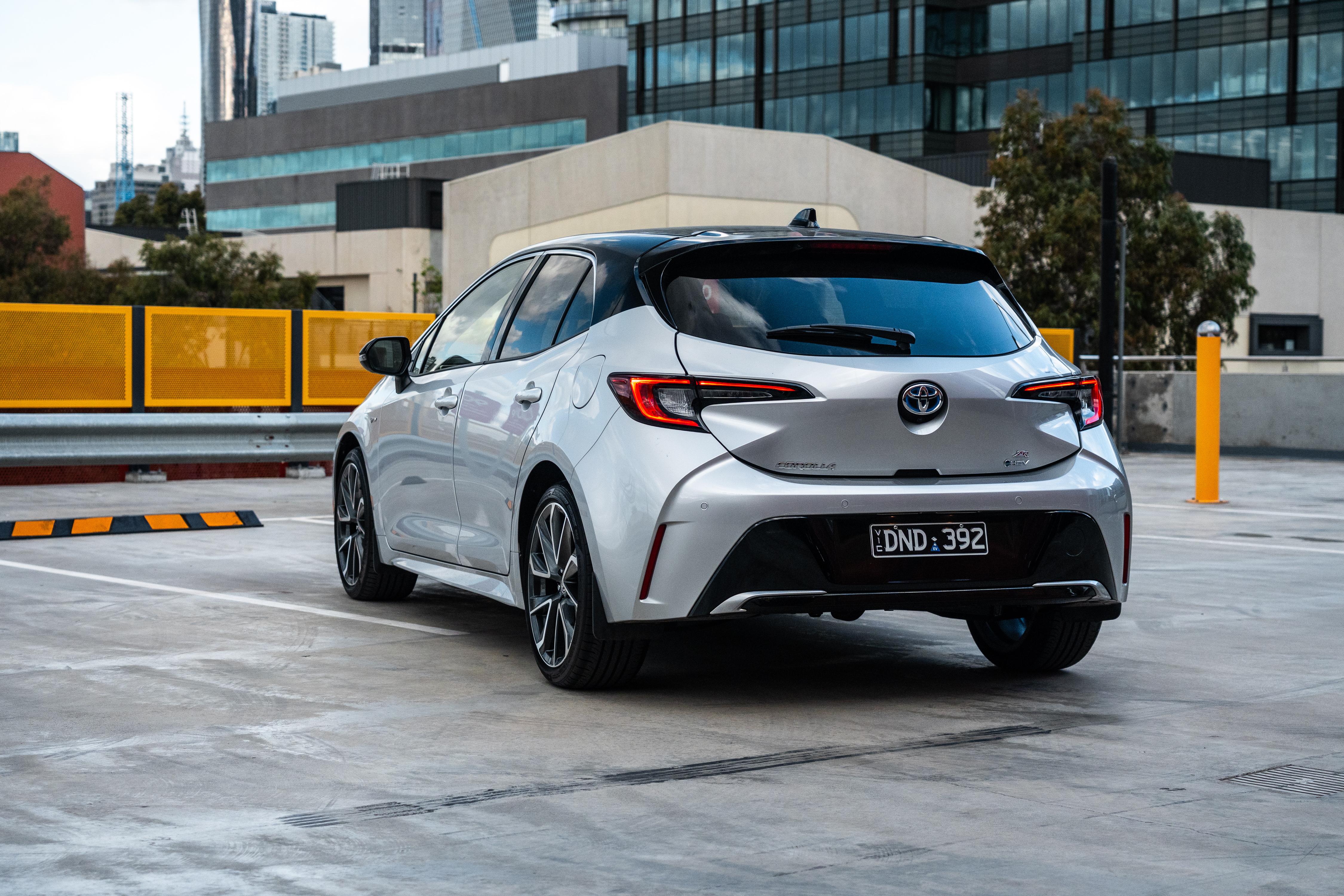
CarExpert can save you thousands on a new Toyota Corolla. Click here to get a great deal.
Click the images for the full gallery
